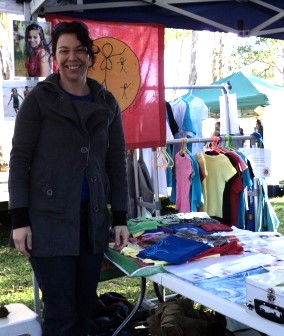I first learned the term ‘social enterprise’ around 2009 when I was managing an Aboriginal Corporation and my funding partner had told me we had 24 months to make the entity sustainable. The entity was essentially a community centre i.e. an entity established to support the community and act as a conduit to valuable services and not a revenue generating venture.
A recent corporate refugee I knew how to identify ways to make money and my social conscious, and board guided what would be appropriate.
Before long we had morphed our textiles project to the beginning of an enterprise stringing together a range of grants set to address women’s health, creative industries and social inclusion.

The problem was – while everyone enjoyed learning how to design and sew nobody was up for participating in mass-production and I couldn’t find a market for high-end once-offs. I knew nothing about the fashion industry in the beginning and while I picked it up, we ended up on the front cover of a national publication, beautiful dresses were worn to city-based formals we just couldn’t get the traction to make a business of it.
Side note: I really didn’t enjoy sitting at the markets and despite my enthusiasm couldn’t seem to raise interest for anyone else to do so. An early clue the enterprise may not have the ideal amount of engagement.

The textiles industry in Australia is tough. And it could be argued that having the time to manage a not for profit AND build a business in an industry you don’t know is even harder.
But what was even more difficult was not having a cohort of likeminded and suitably skilled people who understood the difference between enterprise, social enterprise and not for profits to bounce off.
And the arguments began about who was, and wasn’t paid; who owned the designs; who could and couldn’t participate… Good intentions festered and the could have been social enterprise imploded.
Fast forward 15 years and it’s fair to say I wouldn’t have tried to establish the enterprise without proper co-design, a business case and working capital. But what was I to do? There was a short window to make the entity sustainable (I thought) and I felt I needed to grab at the opportunity that seemed most likely to have revenue generation potential and had at least some interest.
As a consultant I’ve seen countless rurally based not for profit managers grab at social enterprise as a means of finding sustainability. It rarely works.
First, not-for-profit managers who are likely to drive the enterprise activities of small not for profits are not usually working in the sector because of their potent business skills. While of course some do excel, the norm is the manager has risen through the ranks of service delivery and the next logical step was to become the manager. They are content experts who may not have the business skills and certainly not the entrepreneurial balls to ride through the challenges of starting a more volatile enterprise.
(NOTE: This isn’t to denigrate the work of not-for-profit managers, actually, it’s more of a plea do let them to what they are great at and stop the ongoing need to stretch) and, as ACRE – Australian Centre for Rural Entrepreneurship so aptly recommends in the #ruralmanifesto to consider impact over scalability.)
And so capability development, or outsourcing becomes a logical solution – often both. In my region I have met very few consultants who move easily between for-profit and not-for-profit models. To the naked eye it may appear that a business plan is a business plan full stop. However this is far from the case, and in a rural community where markets can be thin and competition high there is even more to consider. And, without the correct approach the skill profile, capacity and appetite for risk the not-for-profit holds may be misinterpreted and, another social enterprise bites the dust.
Capability development is very hard to come by in rural communities with most offerings online or, at best fly in-fly out consultancies and workshops which whet the appetite but don’t quite embed the longer term skills and mindset shift required to deliver a truly successful social enterprise.
PAUSE: But social enterprise doesn’t have to come from an existing not-for-profit. True. And, in the communities I work in it is very rare to see a social enterprise emerge from anything but the ‘sector for good’. Why? Because that’s who does that business.
It’s important to remember health and community services sectors, the sectors who do the business of good, are the largest employers in most regional communities in Australia. In these industries awards, conditions, cultures and the way we do things around here are well and truly established. Effectively the established industry could operate as a cartel, except they are generally too busy competing for thin funding resources and while collaboration may be a sought after principle, it is thrown in the bin when a big chunk of funding is on the table.
PAUSE: I have worked in communities where not-for-profits are more gracious in collaborating across funding streams however have also seen competition is the norm due to never enough funding on the table.
So if a social enterprise was to pop into the eco-system the associated social entrepreneur has better be well-connected, be prepared to dogmatically move forward or have a big bag of candy to hand out to partnering services because they will be seen as competition.
In a small town this doesn’t just mean jibes at networking meetings it can mean strong words in the supermarket aisles, bullying, white anting and overall undermining, a classic rural induction until the person or service expires – or finds its lane and settles into the ecosystem.
And then there’s the business community.
When I was thick in the delivery of social enterprise projects in a very small community one of the three local hospitality business owners got her knickers in a twist because the emerging social enterprise kitchen was undercutting both her prices and poaching her staff. And rightly so. It’s hard to trade in small towns and any kind of competition will be seen as problematic even if it is actually developed to build a future workforce.
In the regional and rural communities I work in there are not jobs in social enterprise, there are few in social impact and still, yes, even in 2024 when I speak to people in the business community about social enterprise they go cross-eyed or, if they are feeling generous tell me that’s the ‘fluffy stuff’.
And in rural communities there aren’t always social enterprise networking groups, nor access to in place education, nor an abundance of successful operating models to draw from. You have to make it up.
For a long time I felt like the only social entrepreneur in the village. So, determined to learn more I jumped on a plane and flew in and out of the city often leaving my kids at 4am and getting home after 9pm days later to participate in a course (the School for Social Entrepreneurs) to learn, and to build up a network. The SSE program wasn’t the only time I did this. And I know I’m not the only rural social entrepreneur who has.
15 years on there is still no social enterprise networking group, there are still no locally delivered courses and we are still flying in expertise or expecting people to leave the community (or go online) to access networks and support.
Sometimes that makes me cranky. I’m sure you can imagine why.
With an eco-system building approach perhaps we’d look at this differently. Imagine for a moment if we (as a community) identified social enterprise as an important way to create social change, drive local economies and bring communities together. Imagine if we:
- Understood and valued social enterprise across government, community, business and not for profits
- Identified local leaders and collectively invested in their skill sets
- Enabled these, or other local leaders opportunities to drive the social enterprise sector offering capability development opportunities in the form of workshops, incubators, workplace mentoring
- Brought in the support we need rather than what’s on tour or seems to look sexy
- Had robust, collaborative and connected networks within and aligned to the local social enterprise community ensuring supply chains, business development, workforce and ongoing capability development could be driven locally, and flowed more readily
My hunch is that this (a) isn’t actually that hard to do if it’s driven locally and (b) would create significant change in local rurally based social enterprise eco-systems.
In fact, I would think we could apply the development of any eco-system to this methodology… Your thoughts appreciated.
While you’re there…
The Ready Communities model is designed to empower collaboration within regional and rural communities. Our pilot, #readymacleay is already demonstrating significant progress as the model encourages and supports local action. To learn more visit www.socialimpactintheregions.com.au
Featured image by: Alina Grubnyak on Unsplash



